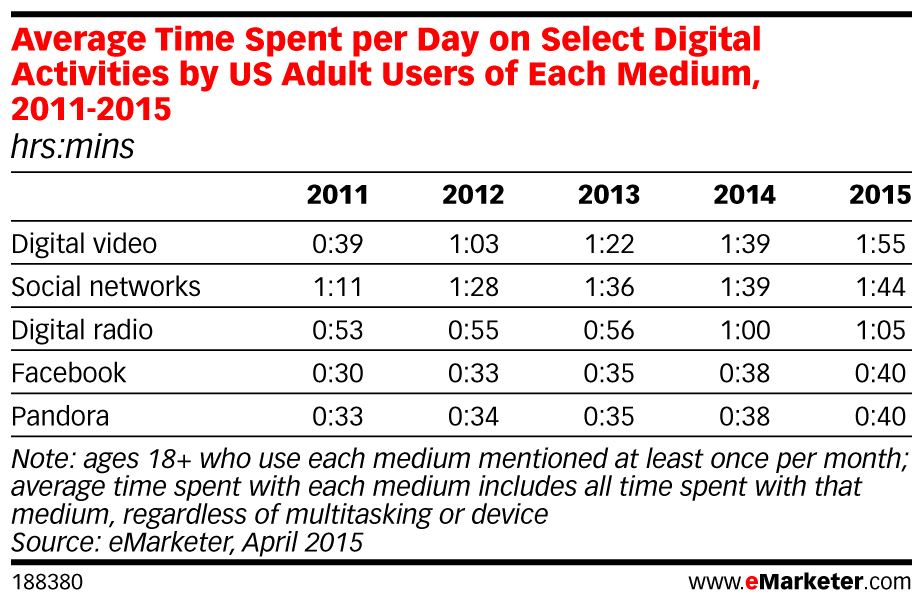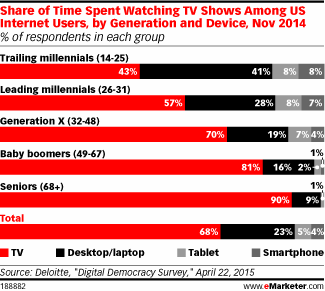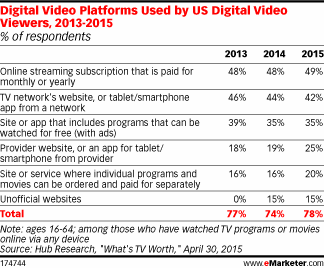Brands
The Explosive Growth of Online Video, in 5 Charts
Online video ad spend is growing at a rapid pace. According to a new report from eMarketer, the “Q2 2015 State of Video,” total ad spend allocated for digital video has jumped from 2.4 percent in 2013 to 4.4 percent today. Sixty-eight percent of U.S. marketers also plan to increase their digital video budgets in the next year.
As the report notes, this shift is due in part because of new video ad offerings from platforms like Snapchat, Yahoo, and Vessel. The report also emphasizes the proliferation of original video content on platforms like Hulu, YouTube, and Amazon as a key contributor to digital video ad spend’s rise.
Even existing cable networks like HBO and Showtime have seen audiences drop their cable packages for digital; in turn, they’re starting to offer standalone subscription services. Others—like ESPN, CNN, and Disney Channel—are joining digitally packaged services like Sling TV.
Media outlets aren’t the only ones that have to anticipate viewers’ changing habits, however. If marketers are to keep up, they need to adapt to these new digital habits and platforms.
For those who want to stay ahead of the curve, here are the top five takeaways from eMarketer’s report.
1. People spend more time with digital video than with social media
This is a landmark year for digital video. It tied with social media in 2014 when it comes to average time spent per day engaging with different digital activities. In 2015, digital video finally pulled ahead. Users are spending an average of 1:55 with digital video each day, and only 1:44 on social networks.
In fact, time spent with digital video now trumps time spent with all other listed digital platforms, including digital radio, Facebook, and Pandora.

2. Viewers are spending more time watching digital video than ever before
The time adults spend watching digital video each day has increased from 21 minutes in 2011 to one hour and 16 minutes in 2015. Meanwhile, time spent watching traditional TV has been decreasing steadily since 2012. This isn’t surprising, given that more and more viewers are watching their favorite shows through connected TV devices like Apple TV and Roku.

To pull ahead of the curve, marketers would be wise to experiment with content and advertising that’s custom-made for digital video, rather than copying and pasting their TV spots onto digital platforms.
3. Especially millennials
According to the report, “trailing millennials” (aged 14 to 25) are the only age group watching more shows on digital devices than on traditional TV screens.

Seventy-two percent of these trailing millennials also use digital streaming services—a higher percentage than any other age group.
As this generation of trailing millennials grows up, they will most likely come to expect that the best content be offered on digital platforms. The advertising that accompanies that content needs to be innovative enough to hold their fleeting attention.
4. Viewers love longform original content and user-generated live-streams
Viewer attention is in high demand, and there appears to be one secret to capturing it: longform original content. That’s the stuff of Netflix, Hulu, and Amazon Prime. All three started out as distribution platforms for licensed content, and all three eventually jumped into creating their own shows.


Meanwhile, video streaming apps like Periscope and Meerkat popped up almost overnight and started to gain traction this year, especially among millennials. A May 2015 study by Horizon Media found that 21 percent of U.S. Internet users would be interested in using Periscope or Meerkat; the majority of respondents were aged 18 to 34.
This boom of user generated content doesn’t mean longform content is leaving any time soon, however. As the report states, “It is a sign of the health and versatility of the digital video market that these and other types of content can coexist and present opportunities for marketers.”
5. Tablet use is soaring
What kind of devices are we watching all of this digital video on anyway? Increasingly, we’re using our tablets and smartphones. In fact, of the devices listed below, tablet use had the greatest annual growth from 2011 to 2015, at 120 percent. And we’re not just watching on the go. We’re also tuning into content on our connected TVs, otherwise known as smart TVs, with an increased usage rate of 23 percent.

While we still watch most of our digital videos on laptops and desktops, their growth stalled in 2015. Suffice it to say, the content world is going mobile, and digital video is no different.
Image by Deb WenofGet better at your job right now.
Read our monthly newsletter to master content marketing. It’s made for marketers, creators, and everyone in between.




